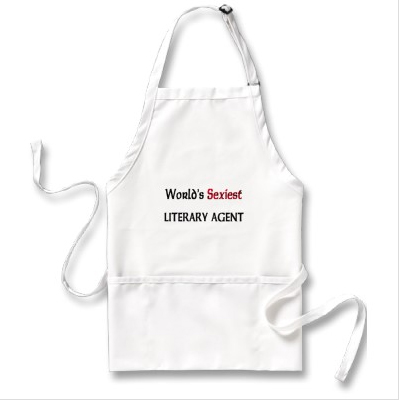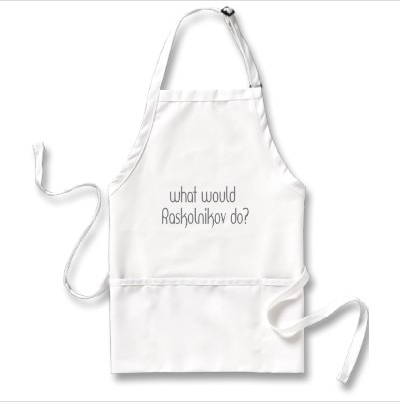I feel like today is the calm before the storm, the week before Black Friday. The Friday after Thanksgiving marks the beginning of the ever-increasing insanity of the holiday season. This year we have five weeks to work late, process hundreds upon hundreds special orders, booktalk until we’re hoarse, wrap and remain cheery, if haggard by Christmas Eve.
Our only concession to Black Friday is opening at 9:00, not 10:00. We will have our sugar plum candy that we give out, at the ready. My Santa hat is clean and ready to go. Getting ready for the last five weeks of the year is much like preparing for war. You have to be well armed, well fed, and not totally exhausted to make it through. Five weeks makes a difference. And if what I’m sensing to be is the case, we will not slowly build up to crazy sales, we’ll be hit hard the last week of November. Having an extra week to shop just means more of the folks who plan ahead will be coming before the beginning of December.
We will field, with politeness and kindness, the special order requests that come in on Sunday with the expectation of Monday delivery. We will try, within 30 seconds of talking to you, to know what books you’d like best. We will decipher as fast as possible botched title requests. This skill is so honed by the week before Christmas that one year a customer hadn’t even opened her mouth and I said, “The Help” and handed her a copy. She was stunned and we made a fast sale and a customer for life.
So on this the last weekend before Small Business Saturday (which has truly been a huge boon to small businesses), I am taking a deep breath. I plan on eating fueling food and drinking lots of water and getting as much sleep as I can, because something tells me this year will be one of the best holiday seasons for independent bookstores in a long while. Customers seems extremely appreciative of indie stores at the moment. Everyday we get new customers who say they want to shop local this season. Mail orders have already increased.
The season will be a blur and that’s just how it should be. It should end with us ragged, out of breath, and proud of a job done well.
Book Bling for the Kitchen
Elizabeth Bluemle - November 15, 2012
Looking for festive literary accoutrement for the holiday kitchen? You can wow your Thanksgiving guests with something out of the ordinary, bookish and bright. I found some great aprons — and for those of you who scoff at the old-fashionedy fussiness of aprons, I will tell you that, while I once thought aprons were only for people on, say, The Waltons, I have come to appreciate their usefulness. There is a REASON aprons were invented, people, and I think I am that reason. Well, I and people like me, people with good intentions and a touch of the klutz.
There are oodles of book-related aprons at zazzle.com, some on Etsy, and a little Googling will get you additional results. Here are a few of the goodies I stumbled upon:
And another comic-book inspired apron, this one for men:
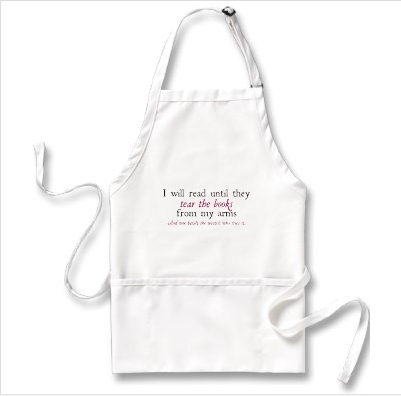
“I will read until they tear the books from my arms. And woe betide the wretch who tries it.” from zazzle.com
A literary boxing match we might like to see:
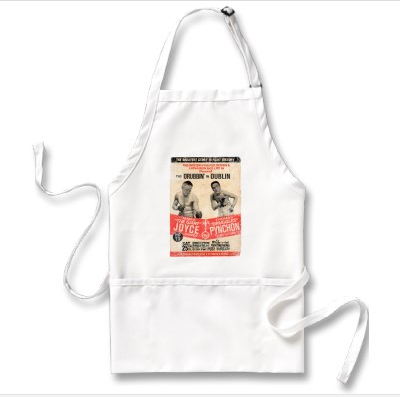
In the “Writer Fighter” series, James Joyce and Thomas Pynchon square off. Designed by strangerstuff on zazzle.com
Proudly proclaim your prowess:
This one cracks me up. Tuck an axe in the pocket:
And finally, one for the kids:
I’ll bet some of you crafty folks have made your own book-related aprons. Anyone?
No One Gives Me Books
Josie Leavitt - November 14, 2012
Today is my birthday. I’ve owned a bookstore for 16 years and for 16 years, I have not received a book as a gift. Everyone just assumes I can get all the books I want. While this is true, there is something so lovely about getting a book as a gift.
There is nothing quite like a good friend shopping for a book for you. I see tremendous thought go into book purchases by my customers. When you give a book you’re really thinking about someone. What do they like? What mood are they in and how can a book help that? Too often it is assumed that I know all the books in the land, therefore it’s pointless to get me a book. Oh, reader, this is not so.
I love being introduced to a book by a friend. Someone introducing me to their favorite author is a privilege. I like learning about my friends by what their book passions are. Why do they like Neruda? How come I’d never read Kaye Gibbons until Elizabeth handed me Ellen Foster? It’s not enough to tell me about these authors, I can’t remember names these days. But a book I’ll remember.
Some of my best book birthdays include my sixth when I got a copy of the Dr. Seuss book, My Book About Me. A gift of Mrs. Piggle Wiggle when I was nine made my Christmas vacation. A tenth birthday present of Julie of the Wolves and I remember so clearly sitting in my room, practically transfixed as I read the book one weekend. I can’t believe I still remember these books.
But also remember a Christmas present in my 20s of The Secret History and Wicked. Gone are the days of someone giving me a cookbook. I still have my Silver Palate Cookbook from 20 years ago. Books create memories for the giver and the receiver. So, remember, just because a bookseller works in a bookstore, doesn’t mean she wouldn’t like a book now and again.
What are some of the books you remember the most being given?
Bookselling the Old-Fashioned Way
Josie Leavitt - November 12, 2012
This past Saturday found my store struggling once again with computer problems. They began quite simply with a broken modem and ended with our computers rendered utterly useless by mid-morning. I have thought that I could never run a bookstore without a computer and I feel more certain of this fact after barely surviving the day.
Our point of sale system went down with the Internet for reasons I still don’t quite understand. But when the computers stop talking to each other, there’s precious little that can be done. You can’t look up anything in inventory because you get on the computer. This made the game of guess-what-the-customer is really asking for all the more difficult. Relying on my own memory for who an author might be or what the title of book really is proved exhausting by the afternoon.
Sandy and I were doing a great job, though. We would help each other out with book support when we could. We were forced to ring up sales on paper receipts and do math. Okay, we had calculators, but there is always pressure, for me at least, to not dyslexically switch numbers when I write them down and then add them. The store was also extremely busy while all of this was going. Why is that always the way? I would love for my next computer breakdown to happen on a Monday morning during a snowstorm.
While ringing up books by hand was irritating, it was not debilitating. Not having access to the Internet was a massive liability. We couldn’t look books up in any way. Nor could we go to any book source to look up a book. For instance, a grandmother called today and asked if we had, or knew of a book about a child with a broken arm. I drew a complete blank. I reflexively went to go to the Internet for a quick search, but couldn’t get online. We could neither sell nor redeem gift cards. Thankfully there weren’t too many birthday parties this weekend, or we would have been in real trouble.
A lovely friend of Sandy’s came to the store Saturday afternoon and fixed the computers so they would work. He was good, but not a miracle worker and the Internet remained out and won’t be fixed until Tuesday. I did find myself using my iPhone to look books up even though it was impossibly small and hard to navigate. I would get the ISBN I needed only to realize that without the Internet I couldn’t place an order anyway.
I was driving home Saturday afternoon after some order had been restored. I got home and thought to myself, this is so trivial compared to what the post-Sandy world has been like for so many people. So, I had to ring people up on paper. Honestly, that’s not that big a deal, it’s inconvenient, but at least I have heat and power, and my store is unharmed. No customers left because we took longer to process their sales than normal. All our customers were appreciative for their books and more than understanding about the situation.
The one thing I learned through all of this: I’m not really qualified to be our IT person, and that young man has just gotten himself a job.
I Was Wrong
Josie Leavitt - November 9, 2012
In my post from September about rushing to put out holiday books, I was fairly adamant that Christmas books should not go out until at least the week of Thanksgiving. Well, I’m here to publicly say I was wrong.
It would appear that the minute the last little trick or treater has returned home, thoughts immediately turn to Christmas. The morning of November 1st I walked into the store and saw my staff about to set up the holiday books. I vehemently disagreed with them and said it just felt too soon. Kelly and JP just shook their heads at me. I snorted and said to put out one shelf of books on our face out picture book display.
Then they came. The people who sensed there were holiday books to be had started sniffing around the books. One woman with a recent breast cancer diagnosis came and said she “didn’t have time to wait while staffers brought out the holiday books for her to look at.” Kelly relayed this conversation to me immediately after the customer left.
Within moments all of the holiday books were on display. We probably sell at least 5 to 10 of these books a day. I am stunned, but people feel the need to shop early and they don’t want to feel bad about it. So, my new rule for the holidays has changed to November 1st for the holiday book display. But, I’m still not wearing my Santa hat until the day after Thanksgiving.
Designing for Digital: A Conversation with Daniel Nayeri
Elizabeth Bluemle - November 8, 2012
In a discussion of book covers earlier this year on the CCBC-net listserv, Thom Barthelmess, curator of the Butler Children’s Literature Center at Dominican University in Illinois, raised a point that particularly caught my eye: “During a publisher panel at the Boston Globe-Horn Book Award Symposium this past fall, a publisher rep talked about an increasing focus on what a book cover looks like postage-stamp size on a computer screen, as so many purchasing decisions are made that way. Makes perfect sense, and it had never occurred to me.”
It hadn’t occurred to me, either, but should have. As any regular reader of ShelfTalker knows, I do have some opinions on book jacket design, and these days, I spend a lot of time looking at tiny covers in digital publisher catalogs on Edelweiss. However, I’d never heard anyone in publishing talk about designing covers with an eye for the online market, so I decided to poll a few editors to find out if this is, indeed, on their radar. As you might expect, the results were mixed: some do, some don’t, some are starting to think about it.
Scholastic’s Cheryl Klein said, “We pay a LOT of attention to this, because not just the retailing but the entire publishing WORLD is so much more digital…. Something needs to reproduce well if it’s reduced in size not just for booksellers, but for reviews and roundups and blog posts and articles anywhere online. It’s become even more important for a cover to have an want-to-pick-it-up-from-across-the-room quality, if at all possible (which translates into standing out when seen small, ironically enough). And of course at Scholastic we’ve always thought about this, thanks to our book club flyers and their reproductions of covers.”
Candlewick’s Liz Bicknell said, “This hasn’t been talked about at CWP, to my knowledge. And online legibility isn’t too much of an issue, since usually the title is listed at the side (or beneath) the cover image. When we had a b&w catalog, we thought about how color covers would look when converted to grayscale. But we solved that one by reverting to a full-color catalog.”
Recently, I spoke with Houghton Mifflin Harcourt’s new digital editorial director (and fab YA author) Daniel Nayeri about this topic. At first, we texted about this via Facebook, and a few weeks later, talked on the phone. Our conversation ranged far and wide, and fell somewhere in between an actual interview and chatting over tapas and a beer. I will recount this text exchange/conversation as faithfully as possible, and trust that you will forgive its casual nature:
Elizabeth Bluemle: Hey, Dan, there’s a discussion of cover art on the ccbc listserv, and someone made a comment I found fascinating: that houses are starting to look at how covers look as thumbnails, since so much buying is done online. Does that happen at your house yet?
Daniel Nayeri: Wow. Sympatico. I was just discussing this with a fellow editor. For what it’s worth, we do think about the thumbnail image when considering covers. With that comes a lot of disadvantages, of course. It requires one to emphasize iconic imagery and high contrast composition, certainly. It makes it tougher to fight for covers that feel “cluttered,” or covers that can’t be read from across a room.
Some people downplay the loss of texture in the digital version, such as metallic stock, embossing, or gritty matte, but those people should look at a chocolate bar after it has lost its luster and then try to pretend something like gloss doesn’t make a difference.
On the other hand, if someone wanted to think of the digital version as the primary, then it could have a few advantages as well. We have to pay extra for things like a fifth color (if we wanted a very specific Pantone chip for example, or a neon color). We also pay a little extra for extra hits of white (say if wanted to make a starry sky shine extra bright). I suppose it would be an advantage to have access to those colors without the cost… but honestly, I think the losses outweigh the gains. I’ve seen the interactive covers, and I’ve been promised animated .gifs, but when was the last time someone sat mesmerized by the design quality of a .gif file? I mean, aside from the ones with baby kittehs.
EB: Good point. Is there a way to weight the process toward the positive, the gains?
DN: I think of this issue as culture building vs. culture mining. There was an article/blog post called Hack the Cover by a designer I like, Craig Mod (@craigmod). He began the conversation from a very artistic design perspective. I loved what he was saying. It projected a world I want to come true. I also fear that a more cynical approach to digital cover design would result in a ton of visual spam, culled from data-mining customers. I think both will exist. Certainly, I hope the artfully made stuff wins out.
EB: So how does a publishing house approach designing with the digital image in mind?
DN: The image has to work as a thumbnail. There are a ton of covers that just don’t work. [A cover needs to be] iconographic, has to work as a one-inch by one-inch image. I will say that Hunger Games is the best cover design in the past ten years. You use bold typography, larger fonts, do a little bit less with the cover. This tends to be hard for middle grade series books with a lot of detailed illustrations, showing all three of the spunky protagonists…. I can’t see Hermione when it’s a thumbnail, so I think we’ll start seeing that sea change in middle-grade covers as well.
Another thing [Craig Mod] talked about was the idea of how the cover now permeates the entire work. It used to just be a dust jacket to protect the folio. That’s not the case anymore. It needs to be more of a herald. His idea was that the cover can set the stage. He showed a book where each chapter opener could have been the cover. Modular design. Iconic image of the sun in red ink, and then the font carries through…. You’re reading the book in these little modules. It hearkens back to the idea of illuminated gospels. I think those are really nice.
There are ways great design can impact the way book design goes and I hope it goes that way. It’s all part of the artistic range. There will always be good books and bad books. Even what image you put up is a decision. There is something to that decision. What image of a petticoat you put up is important — one is additive, one is not.
But I think what’s going to happen is that it’s going to be more of a marketing product. With advertising like Amazon and Google Analytics targeting you, if we are looking at that jpeg as a “movie poster” for the book, then the next step is having covers that pitch to a certain audience. There is a world where we could have multiple covers that speak to different audiences. For girls we ‘pinkify’ and for boys we turn it into Maxim Magazine, and that of course is a huge problem. I’d hate if a nuanced story turns into that…. We can all see the worst of possible worlds where we create an ad out of everything.
EB: It is disturbing how advertising has begun to permeate absolutely everything we do. I always think of M.T. Anderson’s eerily prescient novel, Feed.
DN: In the sci-fi story in Straw House [Nayeri’s quartet of novellas, Straw House, Wood House, Brick House, Blow], there’s a term kids call “chameleon marketing,” and that’s what I think of when I think of book covers designed to meet certain needs. In the story, if you walk into a McDonald’s, their product descriptions can change depending on your needs. [In real life,] Target knows that you’re pregnant well before you announce it, because they keep track of purchases like pre-natal vitamins and some other items. They were sending baby catalogs to women who hadn’t even told their families they were pregnant. The fact is, Target doesn’t get to tell me when I announce I’m having a baby. That’s a big part of your life — dude, stop screwing with people’s lives. We don’t want that sort of invasive marketing.
On the other hand, I’ve found a lot of wonderful things when Google serves up an ad. Sometimes I find cool things. But I wouldn’t want it to be used in a way that dehumanizes the author, or the reader, or the book itself. I wouldn’t want everything to go this way. Again, a terrible way to do this would be to pinkify for girls and brutify for boys.
I don’t think books will ever reach that point, because we’re a one-to-one exchange — author to reader —unlike most other products. I don’t think we’ll ever get to that point where we’re shoving books and authors down people’s throats.
EB: What kinds of advantages do you think designing digitally can offer publishers and readers?
DN: One interesting way of targeting book covers to different audiences is with crossover fiction. Finding a cover that is for both kids and for adults is an exceedingly difficult job. There is a world where that kind of targeted approach would work.
A teacher being able to customize annotations for students could be amazing. If it’s done well and doesn’t turn into some internet wall of graffiti but was handled correctly, it could lead to some really good discussions. To me that’s an interesting possibility… there’s promise there.
We’ve also talked about pop-up videos. Kobo is doing cool things. Hyperlinking is neither here nor there. I’ve never been so distracted that I think, I need to go to Wikipedia to look up this thing about whaling before I can watch an ad for a movie I’m going to pay for. We are totally beyond the pale at this point. If pop-ups become that crazy, that would be hateful, too.
That’s the rub. If it doesn’t apply to you, it’s hateful. If it does, it’s wonderful.
EB: I think you’ve just described political campaigns, too.
***
Many thanks to Dan for his fascinating insights. I learned so much during our conversation, and we were only just able to scratch the surface of the topic. Publishers, authors, readers — what say you about this brave new world of digital design?
Literacy in Jammies
Josie Leavitt - November 7, 2012
Kenny Brechner, owner of DDG Booksellers in Farmington, Maine, worked with Betsy Turcot, the 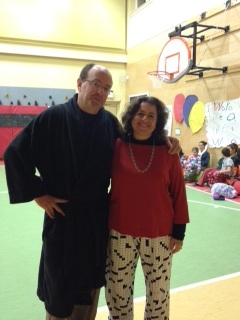 librarian at the local school, this Monday to put on the 15th Annual Jammie Night Celebration of Reading and Community that featured none other than Elizabeth Bluemle. The event is an homage to family literacy. Kenny and Betsy have been doing this for 15 years and it’s simply wonderful. The entire school community is invited to come back to the school for an evening program that finds teachers in their jammies reading to kids before an author presentation.
librarian at the local school, this Monday to put on the 15th Annual Jammie Night Celebration of Reading and Community that featured none other than Elizabeth Bluemle. The event is an homage to family literacy. Kenny and Betsy have been doing this for 15 years and it’s simply wonderful. The entire school community is invited to come back to the school for an evening program that finds teachers in their jammies reading to kids before an author presentation.
Elizabeth and I drove up to Maine together and went to Kenny’s store before the event. It’s always such a treat to finally see a colleague’s store. Kenny’s store is chock full of a great book selection and some of the best sidelines I’ve ever seen. Within minutes of entering the store two young women walked in. One of the young women looked really familiar. At first I couldn’t place her, but  then it hit me: she grew up shopping at our store. There standing in Kenny’s store was someone who had been shopping at our store since she was seven. Rachael is now a junior at the University. All of were stunned by the smallness of the book world.
then it hit me: she grew up shopping at our store. There standing in Kenny’s store was someone who had been shopping at our store since she was seven. Rachael is now a junior at the University. All of were stunned by the smallness of the book world.
The event that brought us to Maine encourages kids to come to school in their jammies for an evening program centered on reading. Pajama Night has become a massive event for families. We got to the school early and already there were families in the gym in their PJs. One thing I noticed was kids in jammies at school think that sliding on the gym floor is just about the best thing, ever. There were as many parents in their PJs as kids. Everyone just seems to love this event, as evidenced by the more than 200 people who attended.
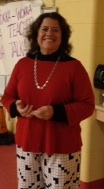 Betsy runs a great event. Elizabeth was coming to the school in support of the paperback release of How Do You Wokka-Wokka? Betsy prepped the kids for the event by reading the book to 20 different classes, so by the time Elizabeth got there, the kids knew her and her book. Kenny helped get the kids excited by having a How Do You Wokka? contest that invited the kids to come up with their own version of a Wokka. I should explain the book is about joyously celebrating movement and rhyme, with contest line being: I wokka wokka like…” Kids submitted their selections; one girl’s creation was, “I wokka wokka like a girl go shopa shop.” Kids at the school also made huge posters of ways they wokka, which hung all over the gym.
Betsy runs a great event. Elizabeth was coming to the school in support of the paperback release of How Do You Wokka-Wokka? Betsy prepped the kids for the event by reading the book to 20 different classes, so by the time Elizabeth got there, the kids knew her and her book. Kenny helped get the kids excited by having a How Do You Wokka? contest that invited the kids to come up with their own version of a Wokka. I should explain the book is about joyously celebrating movement and rhyme, with contest line being: I wokka wokka like…” Kids submitted their selections; one girl’s creation was, “I wokka wokka like a girl go shopa shop.” Kids at the school also made huge posters of ways they wokka, which hung all over the gym.
By the time Elizabeth started her reading the gym was packed. Elizabeth had the crowd rapt through her very funny PowerPoint presentation I had never seen before. I loved that she said you don’t have to study writing to be a writer. Then she read her book. The totally cool thing was she read it with a drum beat behind her that just reinforced the rhyme of the story. Kids were bopping along to the story. Then Elizabeth asked kids how they wokka-ed and shy little voices came through the cordless mic about, “I wokka-wokka like a bunny go hoppa-hoppa.” I was dying of cuteness. Then everyone danced out their wokka. Kids are cute enough as it is, but put a roomful of them in their PJs dancing around and you’ve got a most memorable event.
Elizabeth signed many books. I noticed while she was signing, that there are as many kinds of jammies as there are kids who get shy when meeting authors. The only little girl in a nightgown left the signing line while hugging her book exclaimed, “I’m going to be a writer!”
It was such a lovely evening of families coming together to not just to celebrate reading, but to rejoice in it.
The Tooth Fairy Shops Local
Josie Leavitt - November 5, 2012
We have a lovely relationship with most parents who shop at our store. Often we help parents keep present shopping under wraps while browsing with children in tow. At Christmastime books will literally be thrown at us to hide. Friday I had my encounter with the Tooth Fairy.
A young mom was shopping with her recently toothless daughter. They had spent a fair amount of time looking at fairy books. When they were ready to be rung up the mom said very loudly, “You do business with the tooth fairy, right?” And she winked. At first I was thinking that we had gotten a new vendor since I came from a long weekend away. The poor customer was now looking nervous and I quickly caught on.
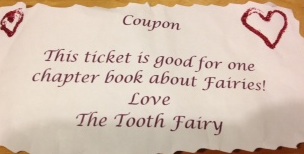 “Of course we do business with the Tooth Fairy.” I said loud enough for the little girl to hear. Before we got the transaction started, the mom threw a $20 bill at me and then presented me with the cutest coupon I’ve ever seen. Samantha, the new owner of a fairy book, seemed pleased to see the transaction finish. I asked if I could keep the coupon and the mom nodded. Samantha looked at me and asked why I wanted it back. I told her the Tooth Fairy is a meticulous record keeper and I was just trying to keep her happy.
“Of course we do business with the Tooth Fairy.” I said loud enough for the little girl to hear. Before we got the transaction started, the mom threw a $20 bill at me and then presented me with the cutest coupon I’ve ever seen. Samantha, the new owner of a fairy book, seemed pleased to see the transaction finish. I asked if I could keep the coupon and the mom nodded. Samantha looked at me and asked why I wanted it back. I told her the Tooth Fairy is a meticulous record keeper and I was just trying to keep her happy.
Later that day another mom came in explaining that she and her girls were buying books because the Halloween Fairy lets them buy a book for every three pieces of candy they give her. Then the Halloween Fairy shares her candy with all the fairies, so they all have enough candy. This elaborate plan was excitedly and haltingly explained by Lilla who was shopping for three books!
Kids shopping for books at the behest of Fairies, who all shop local, just about made my year.
Sandy Relief + F2B + Island Discovery + New Visions Award
Elizabeth Bluemle - November 2, 2012
We of The Flying Pig Bookstore have often wondered if author Kate Messner has a clone, because she gets more accomplished than any three human beings we know. This week is no exception. The winds from Sandy’s wake hadn’t yet subsided before Kate devised a terrific fundraising idea to help the Red Cross help those hit hard by the hurricane: a “talent auction” featuring manuscript critiques, Skype visits, phone calls, marketing consultations, virtual writing workshops, and much more, from children’s book agents, editors, authors, and illustrators.
KidLit Cares is the name of this endeavor, and we hope you’ll check out the items. When people chip in to help friends and neighbors across the nation rebuild from devastation, they don’t expect anything in return. So it’s an extra gift to get something — many somethings — that are extraordinary!
Addendum: For folks wishing to donate their skills to #KidLitCares, Kate adds this information: “Joanne Levy will be picking up the baton for a Round Two & I have an email addy for those who wish to donate – kidlitcares@joannelevy.com.”
Thanks so much, Kate and Joanne!
***
My sister called me this morning. “Liz!” she crowed into my voicemail. (She’s the only one still allowed to call me ‘Liz.’) “You should come over tonight! It’s the 40th anniversary of Free to Be…You and Me, and we should celebrate by doing the whole thing. Still know every note and word? I do. ‘Hi, I’m a baby.’ What’s the next line?”
I think it would not be an exaggeration to say that we listened to that record hundreds of times during our childhoods. We really DO know every word and note. In fact, that groundbreaking work celebrating individuality, diversity, and community was so formative in my life that, some thirty years later, FREE TO BE was the first show my co-director and I chose to inaugurate our local community theatre endeavor, the Charlotte Town Players. We had a cast of 50, from age 4 to age 84, and it was a blast! Just as relevant to today’s kids, and as funny and entertaining and touching and inspiring, as it had been for us.
If you haven’t already introduced your children to it, trust me, they will be singing along and reciting the poems by heart right along with you. The Running Press reissue of the book includes the CD. These truly are stories for free children, and I was so delighted my sister noticed the Slate.com articles (here and here) and called on our 40th F2B anniversary.
***
It’s a good thing I do check in with Facebook now and again, because the other day, fabulous children’s book illustrator Kevan Atteberry posted a link to this L.A. Times article about the probably discovery of the cave that housed the Native American woman whose story inspired Scott O’Dell to write the Newbery Award-winning novel, Island of the Blue Dolphins. I hadn’t remembered (if I’d ever known) that there was a real woman who jumped ship to swim ashore for a baby, and was left behind, alone, on that island all those years ago, but it makes sense. Real life always provides a kind of scope, awe, wonder, and terrible beauty that we would be hard-pressed to invent.
I won’t give away the content of the article here, but will say the irony of the “Lone Woman of San Nicolas'” eventual death saddened me, while the descriptions of her sturdy good cheer and strength were lovely and heartening. Thanks for sharing this, Kevan.
***
Finally, just got word that, because of Hurricane Sandy, the deadline for the New Visions award from Tu Publishing has been extended to November 14.
Here’s how the award is described on the Tu Publishing website:
“TU BOOKS, the fantasy, science fiction, and mystery imprint of LEE & LOW BOOKS, award-winning publisher of children’s books, is pleased to announce the first annual NEW VISIONS AWARD. The NEW VISIONS AWARD will be given for a middle grade or young adult fantasy, science fiction, or mystery novel by a writer of color. The Award winner receives a cash grant of $1000 and our standard publication contract, including our basic advance and royalties for a first time author. An Honor Award winner will receive a cash grant of $500.”
So, writers of color, take note! Writers of pallor, pass this along to your friends! Can’t wait to read the results!
***
And those of you still affected by the hurricane, please stay safe and let those of us who can help know what will most help. Take care!
Can Kobo Level the Playing Field?
Josie Leavitt - November 1, 2012
The Kindle has done much to erode sales at brick and mortar bookstores. I think mine is not unique in that there are customers I haven’t seen in the store for a year or longer. These folks, at the least the five I spoke to, all have confessed to getting a Kindle. These folks have stopped buying physical books. They only read on their e-readers. While I don’t understand this, I have to find a way to get these folks buying their e-books from me.
There was an inelegant solution with Google. Indies could be affiliates of Google and get a small percentage of the e-book sale through their website. Shortly after the deal went through, Google began letting indies know they didn’t much care for us. Many stores were cut off just as they started to build campaigns around being able to sell e-books. The final blow came when Google announced they were opening their own store and would no longer let indies sell e-books. This goes into effect on January 13th.
The American Booksellers Association was committed to helping us find a way to sell e-books. Enter Kobo, the e-book and e-reader solution. I have to admit, until September, I’d never heard of Kobo. But as I’ve learned more, I become more and more impressed, but I’m still skeptical. Indie bookstores who sign up will be able to buy e-readers right from Ingram. So, now folks can come into my bookstore and buy an e-reader. We are trying to get them away from Amazon during the holiday season.
This could be genius. A lot of the success of this program rests in our hands. As booksellers we have to embrace this and really push it. We have to have that hard conversation that none of us likes to have customers: we know you have an eReader or are thinking of getting one, shop local for that and we can sell you eBooks. We have to concede that we’re losing a part of the book buying pie before we can get folks to be eReaders and eBooks from us. Not everyone is comfortable with that.
Some bookstores argue that we should all stay focused on what we do best which is selling physical books. Let’s face it, we all opened our stores because we love books, real books (please don’t get all mad at me for saying that, but reading a screen is not the same thing as a book with pages, a spine and that wonderful book smell) that you can hold in your hand or open on your lap with your child ready to hear a story. We do do that well. But a lot of us are tiring of the “did you know you could buy eBooks from us” discussion. Customers found it difficult to navigate the Google wallet and often there were just too many steps involved to make for a smooth transaction. One thing I have to give Amazon is they know how to make just about every aspect of shopping easy. Come the holidays, the easier the experience the more likely it will be to be repeated.
Stores that have already signed up should be receiving their Kobo eReader displays next week. Payment for the ten eReader display aren’t due until January 15th and they are fully returnable until February. So, aside from the initial outlay, which is not inconsiderable, there is little risk. The challenge is selling the devices. Kenny Brechner, owner of DDG Books in Farmington, Maine has a great link on his website to Kobo.
Kenny’s advice to customers is simple: if you’re going to go the eReader route, do it with us. I think this is sage advice. By selling the devices in the store we are hopefully creating our own closed loop of device sales and eBook sales. I hope by heeding his advice we take the stigma, and sometimes shame, out of buying eReaders and eBooks for our customers. Now, perhaps we can have our cake and eat it too.




